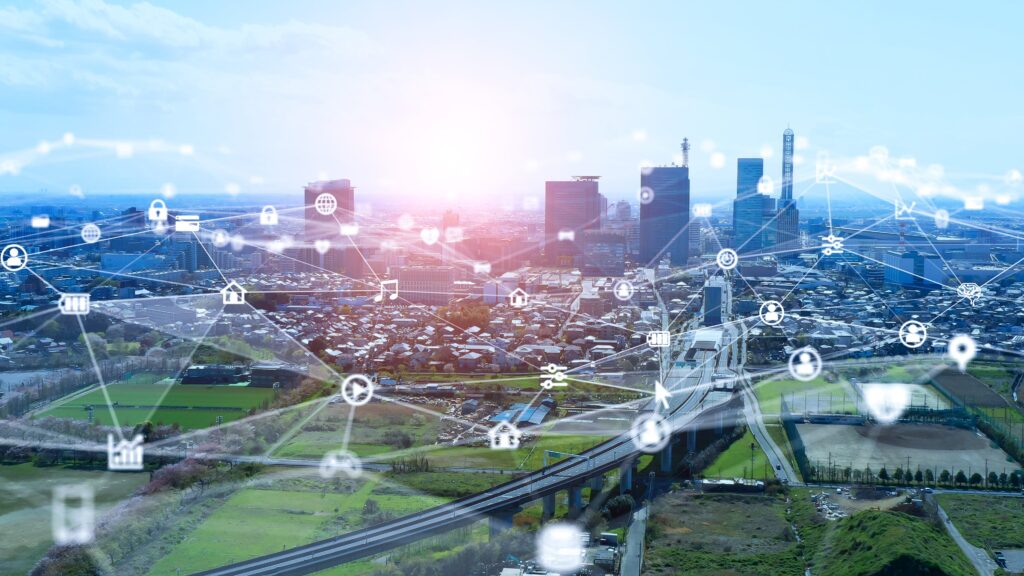
The Internet of Things is the most used term. The innovations in this field have been in the news for quite some time. Many IOT companies specialize in developing hardware and software solutions and IOT platforms that enable devices to communicate and exchange data with each other through the Internet.
These IOT companies are not only focused on enhancing connectivity and data exchange but are also investing in Artificial Intelligence, Machine Learning, and blockchain technologies to make IoT devices more intelligent and secure.
This blog is specially written for those who need help to grasp new technologies and find themselves lost in the Google search bar. This blog is designed to provide comprehensive information about this booming technology named The Internet of Things. Come on, hop in, and enjoy the ride into this new technological marvel.
Table of Contents
What is the Internet of Things (IoT)?
The Internet of Things (IoT) is a network of physical devices that can connect and exchange information with other devices and the cloud. IoT gadgets regularly comprise technology, which includes sensors and software programs.
These IOT devices, often called “smart” or computing devices, have the extraordinary ability to collect data, communicate with each other and external systems, and, in some cases, make autonomous decisions based on the information they gather.
IoT is all about connection. Devices within the IoT ecosystem are linked through the same Internet protocol, forming a vast and intricate network. This network enables seamless communication and data sharing between devices, allowing them to work together harmoniously. The devices can be as diverse as smartwatches, environmental sensors, industrial machines, smart objects, or even autonomous vehicles.
What makes IoT genuinely fascinating is its ability to bridge the gap between the digital and physical worlds, enabling us to interact with the environment in unprecedented ways.
IoT has many and varied applications, and its effect has permeated many sectors, which include production, transportation, healthcare, and agriculture. As the wide variety of connected devices continues to develop, the net of factors will play a key function in shaping our globe and changing how we stay, function, and engage.
In the commercial enterprise environment, IoT devices monitor parameters such as temperature, humidity, air grade, electricity consumption, and gadget operation. These facts can be instantly analyzed to identify styles, trends, and anomalies, assisting groups in enhancing their operations and growth profits.
What Are IoT Devices?
IoT devices are hardware devices that include sensors, devices, home equipment, and other structures that acquire and transmit data over the net. They’re programmed for specific applications and can be integrated with other IoT devices. For instance, an IoT device in your vehicle can detect traffic and mechanically ship a message about it for you to navigate accordingly.
Types of IoT devices
IoT devices, also known as IoT hardware devices, come in various forms and serve specific functions in the Internet of Things ecosystem. Some common types of IoT physical devices include:
- Sensors: These devices detect and measure physical parameters such as temperature, humidity, pressure, light, motion, etc. Sensors are essential for collecting data from the physical environment.
- Actuators: Actuators respond to commands or data inputs by performing physical actions. Examples include motors, servos, and solenoids, which can move, open, or close objects based on IoT system instructions.
- Controllers: IoT controllers manage the operations of devices in the network. They process data, make decisions, and transmit commands. Common examples are microcontrollers, Raspberry Pi, and Arduino boards.
- Wearables: IoT wearables include devices like smartwatches, fitness trackers, and health monitoring devices. They collect data about a person’s health, activity, and environment.
- Actuated Valves: These devices control the flow of fluids or gases in industrial applications and environmental monitoring systems.
- Smart Home Devices: These encompass a wide range of IoT devices designed for home automation, including smart thermostats, smart locks, smart lights, and connected appliances.
- Industrial IoT (IIoT) Sensors: IIOT sensors are used in industrial settings to monitor equipment, detect faults, and optimize processes. Examples include vibration sensors, pressure sensors, and flow meters.
- Medical IoT Devices: These include devices like remote patient monitoring equipment, insulin pumps, and connected medical instruments used in healthcare applications.
Why is the Internet of Things (IoT) so important?
The Internet of Things reduces human exertions in lots of responsibilities and provides plenty of statistics. When people have information, they sense that everything around them is under control.
The most compelling reason for IoT’s importance lies in its potential to impact our daily lives. From our morning routines to our workdays and beyond, IoT has the power to enhance our experiences in countless ways:
- Effortless Mornings: Imagine waking up to a warm, well-lit home where your coffee is brewed to perfection. IoT devices automate these tasks, making your mornings more efficient and enjoyable.
- Smart Home Comfort: IoT-enabled smart homes let you control lighting, temperature, and security systems remotely. Whether you’re at home or away, you can adjust settings to match your preferences, creating a comfortable and secure environment.
- Virtual Companions: Voice-activated smart assistants like Amazon’s Alexa and Google Assistant are always ready to assist. They provide news updates, answer questions, and even control other IoT devices with simple voice commands, making daily tasks a breeze.
- Health and Fitness Partners: Wearable IoT devices, such as fitness trackers and smartwatches, track your steps, monitor heart rate, and analyze sleep patterns. They offer personalized insights, motivating you to maintain a healthier lifestyle.
- Efficient Energy Use: IoT-enabled thermostats and appliances optimize energy consumption. They adapt to your preferences and habits, reducing energy waste and lowering utility bills.
- Grocery Shopping Simplified: IoT can keep your fridge stocked. Smart fridges equipped with cameras and sensors can monitor food levels and expiration dates, sending you grocery lists and alerts to ensure you never run out of essentials.
- Safer Driving: IoT is enhancing road safety. Connected car systems provide real-time traffic updates, warnings about hazardous conditions, and even assistance in finding parking spaces, making your daily commute smoother and safer.
These impacts of IoT are seamlessly integrated into our daily routines, enhancing our quality of life and simplifying everyday tasks.
Imagine waking up to a home that has already adjusted the thermostat and even turned on your favorite playlist. The ultimate guide to smart home automation can help you realize this dream. [Explore “The Ultimate Smart Home Guide“]
As we continue our journey, we’ll delve deeper into the inner workings of IoT, exploring how it functions and the technologies that make it all possible.
How does IoT work?
An IoT gadget consists of sensors/gadgets that “communicate” to the cloud through a few kinds of connection. Once the information is inside the cloud, the software program studies it and then decides to take action, such as sending an alert or routinely putting in place sensors/gadgets without the need of the consumer. But if consumer input is wanted or the user wants to log into the device, the user interface permits them to do so. Any edits or actions the consumer takes are then sent in the contrary direction by way of the machine: from the user interface to the cloud and back to the sensors/devices to make a few alternates.
1) Sensors/gadgets
First, sensors or gadgets acquire information from their surroundings. This data may be as easy as a temperature measurement or as complex as a complete video. We use “sensors/devices” because multiple sensors can be connected, or sensors may be a part of a tool that does more than just sense matters. For instance, your cellphone is a device that has multiple sensors (digicam, accelerometer, GPS, and so forth)
2) Connectivity
A variety of techniques, including as WiFi, Bluetooth, low power wide place networks (LPWAN), Bluetooth, cellular network, satellite network, and ethernet direct internet connection, can be used to connect sensors and devices to the cloud. Trade-offs exist between energy consumption, range, and bandwidth for each option. Choosing the connection method is crucial and varies based on the specific IoT application.
3) Statistics processing
The software application will begin processing the data as soon as it enters the cloud. For instance, this could be as easy as verifying that the recorded temperature falls within a reasonable range. It might also be quite complex as using computer vision on a video to see objects (like burglars on the possessions),. However, what happens if there is an outsider on the property or if the temperature is too high? Here’s where the User comes into play.
4) User interface
Furthermore, the facts are useful to the person who uses them. This may be through notification to the consumer (e-mail, text, notification, and many others.). As an example, a textual content alert while the temperature inside the employer’s cold garage is too high.
A consumer might also have an interface that lets them proactively log into the machine. For example, a user may need to check video feeds on unique gadgets through a telephone app or internet browser. However, it is only sometimes a one-way avenue.
Depending on the IoT software, the person can carry out a motion and influence the machine. For example, a person can remotely regulate the temperature in a cold storage room through an app on their phone. And some actions are performed automatically. Rather than waiting on the way to set the temperature, the machine should do it automatically using predefined rules. Instead of just calling you to warn you of intruders, the IoT gadget can also automatically alert protection teams or applicable government.
What are Real-World examples of the Internet of Things?
The true power of the Internet of Things (IoT) lies in its ability to transform our lives. In this section, we’ll explore practical applications of IoT across various sectors, highlighting the tangible impacts and improvements it brings.
Healthcare
Company: Philips Healthcare
- Use Case: Philips uses IoT to enhance healthcare through their HealthSuite digital platform, which connects medical devices, electronic health records, and data analytics. This platform enables remote monitoring, early detection of health issues, and personalized patient care.
- Impact: Improved patient outcomes, reduced hospital readmissions, and more efficient healthcare delivery.
Manufacturing
Company: Rolls-Royce
- Use Case: Rolls-Royce employs IoT for predictive maintenance of aircraft engines. Sensors collect data on engine performance, allowing the company to predict maintenance needs and reduce unplanned downtime.
- Impact: Significant cost savings and increased aircraft availability.
Agriculture
Company: John Deere
- Use Case: John Deere’s IoT solutions include tractors and farm equipment with sensors and GPS technology. These devices collect data on crop health and soil conditions, helping farmers optimize planting and harvesting.
- Impact: Increased crop yields, reduced resource usage, and improved farm efficiency.
Smart Homes
Company: Nest Labs (owned by Google)
- Use Case: Nest offers smart thermostats and security cameras that learn from users’ behavior and adjust settings accordingly. These devices enhance energy efficiency and home security.
- Impact: Energy savings, improved comfort, and enhanced home security.
Transportation
Company: Tesla
- Use Case: Tesla’s electric vehicles have IoT sensors and software for autonomous driving capabilities. These vehicles receive over-the-air updates for continuous improvement.
- Impact: Safer, more efficient driving, reduced accidents, and enhanced navigation.
Energy and Utilities
Company: E.ON
- Use Case: E.ON, a European energy company, uses IoT to create smart grids that optimize electricity distribution, reduce energy waste, and integrate renewable energy sources.
- Impact: Enhanced grid reliability, reduced energy consumption, and increased use of renewable energy.
Financial Services
Company: Mastercard
- Use Case: Mastercard employs IoT for contactless payments using smartwatches and mobile phones. They provide a secure and convenient payment experience.
- Impact: Faster transactions, increased payment security, and improved customer experience.
Environmental Monitoring
Organization: The Ocean Cleanup
- Use Case: The Ocean Cleanup deploys IoT sensors and technology to track and collect ocean plastic waste. These sensors help identify areas with high plastic concentrations.
- Impact: Improved ocean cleanup efforts and increased awareness of plastic pollution.
Retail
Company: Amazon Go
- Use Case: Amazon Go stores use IoT sensors and computer vision to enable cashier-less shopping experiences. Shoppers pick items and walk out, with the app automatically charging their accounts.
- Impact: Streamlined shopping, reduced checkout times, and enhanced customer convenience.
Retailers are harnessing the power of IoT to create more personalized shopping experiences and optimize their operations. [Explore “How IoT is transforming retail”]
As we continue to explore IoT in this handbook, we’ll uncover even more fascinating applications and delve into its limitless potential.
How can IoT improve our lives?
IoT’s significance extends far beyond the confines of any single industry. It has become a cross-cutting technology that permeates nearly every sector, promising revolutionary changes
Automobiles
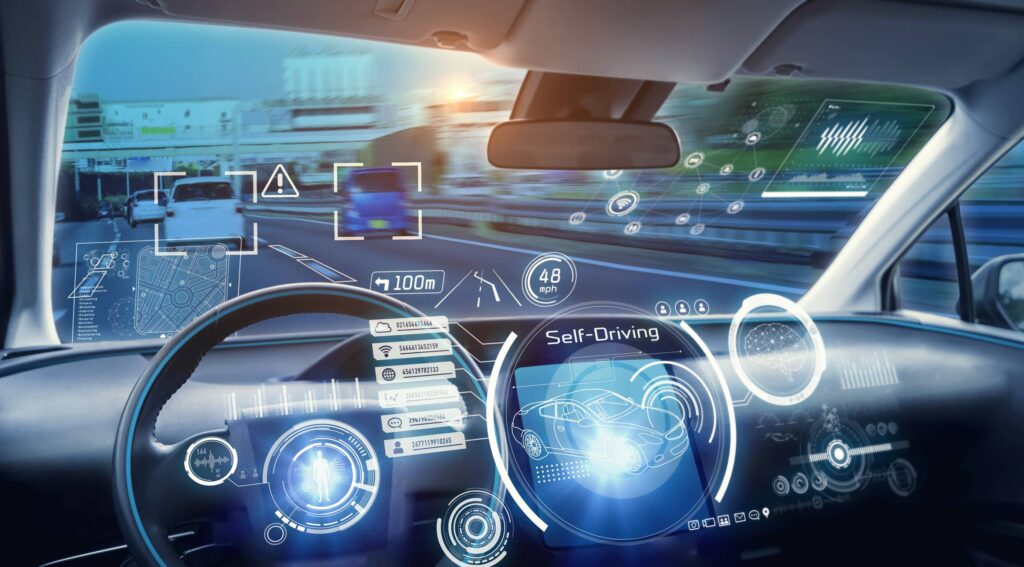
Automobiles can connect to the internet in many ways: IoT applications used for the dash cams, the infotainment structures, and the linked gateway and to acquire data from the brakes, accelerator, speedometer, odometer, wheels, and fuel tanks to track the overall performance of the driver.
IoT offerings have numerous uses for connecting cars, consisting of tracking automobile fleets, which help in enhancing fuel financial systems and slicing prices. The IoT assists mummy and daddy while it video displays units the kids’ riding behaviour and also allows automatic notifications of friends and spouse and children within the occasion of a car accident; IoT predicts and avoids the want for automobile preservation.
Smart Homes
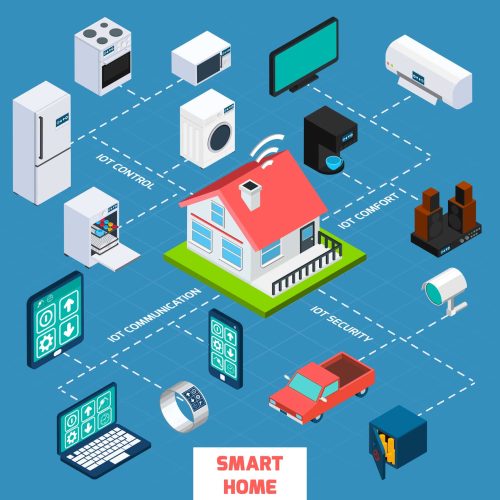
The primary aspirations of the current generation at home are to improve home networking, safety, and efficiency. Thermostats provide an excellent temperature control system, and smart homes monitor energy usage.
Air quality IoT sensors can be installed in specific locations to note down the Air quality of the region, the amount of particulate matter(PM) and other such components in the air. . Door locks, security cameras, and water leak detectors are domestic protection systems that can become aware of and forestall dangers and alert homeowners.
The home-based gadgets that are internet-related are used for such things as turning off lights simultaneously when no one is at home. The upkeep and management of apartment properties, locating items that are lost as installing IoT devices for theft tracking systems, and automating routine activities like vacuuming and coffee-making can be done with IoT.
Infrastructure
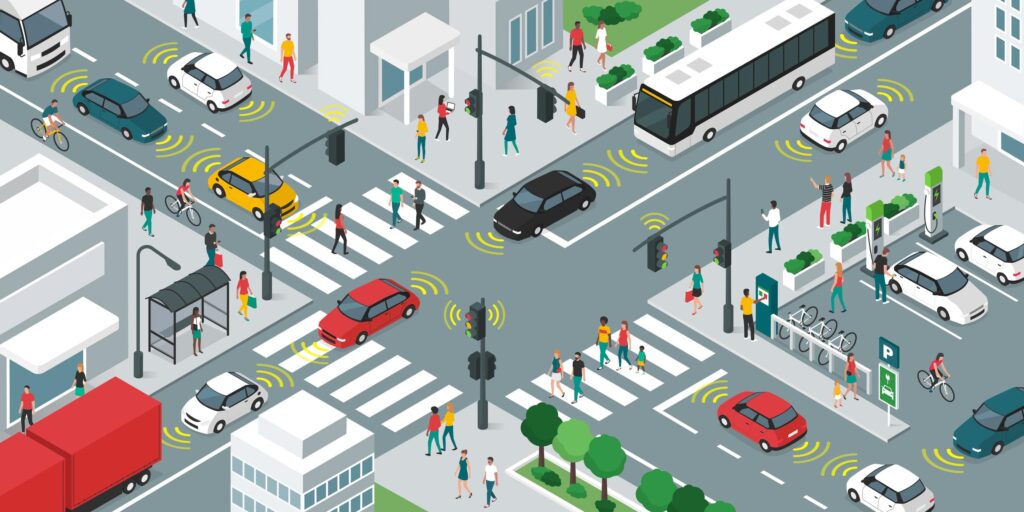
Infrastructure upkeep and planning have become more powerful due to IoT applications. Governments use IoT packages to deal with the troubles with infrastructure, health, and environmental departments. The Internet of Things is used to study the degree of radiation and air quality. The IoT services are used in smart lighting solutions to decrease energy prices. It identifies the need for the repair of vital infrastructure tasks, together with roads, bridges, and pipelines.
Manufacturing
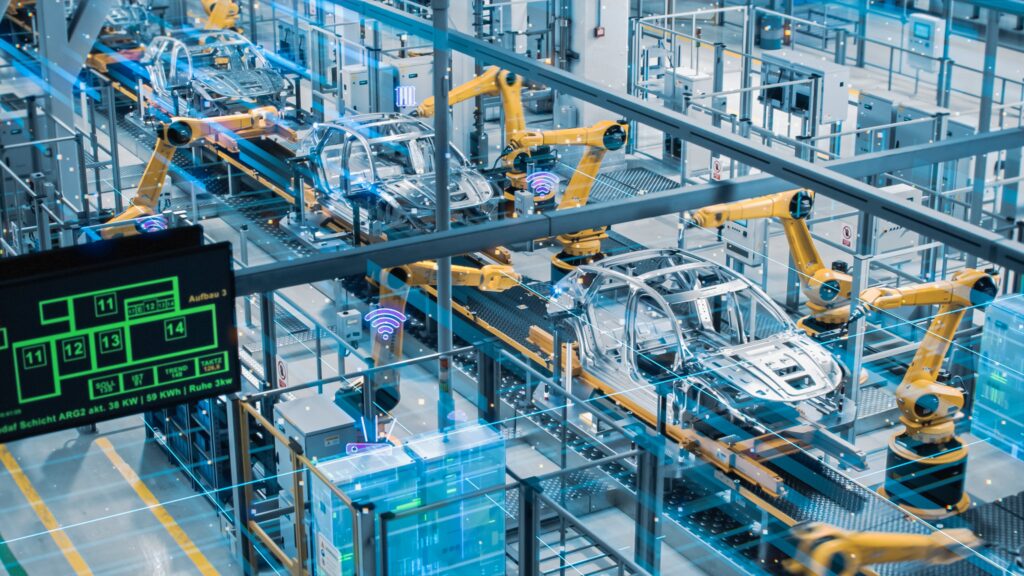
Robotics and sensor-powered analytics raise productivity in automation and maintenance. It includes stock management, dealer connections, fleet management, and preserving business and industrial areas. IoT devices can aid in delivering chain control.
Retail
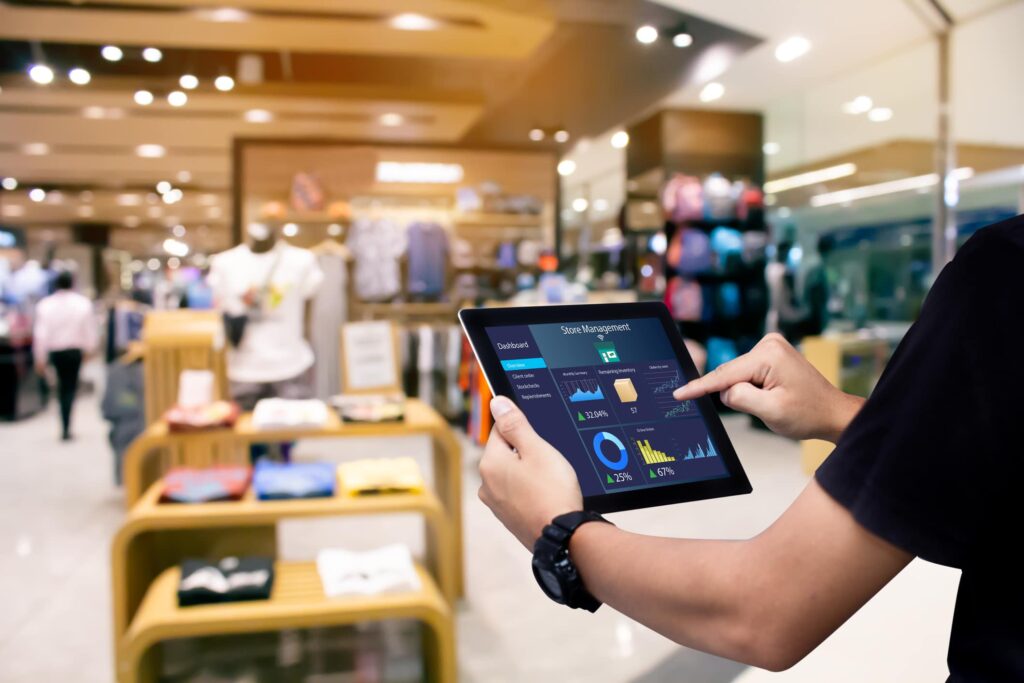
IoT helps stores manage inventory more effectively in the retail industry. Smart shelves with sensors automatically reorder products when stock is low, ensuring items are always available for customers.
Healthcare
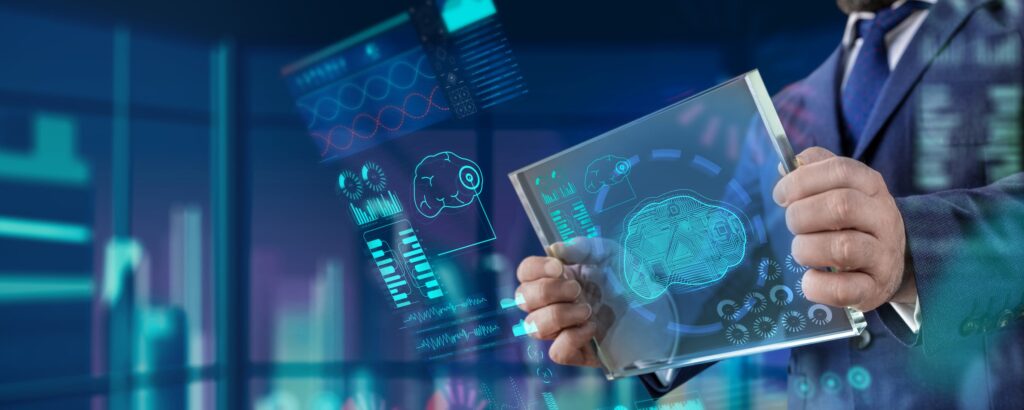
IoT enables remote patient monitoring in healthcare, helping physicians track vital signs and deliver timely interventions. It enhances the quality of care, reduces hospital readmissions, and ultimately saves lives.
Agriculture
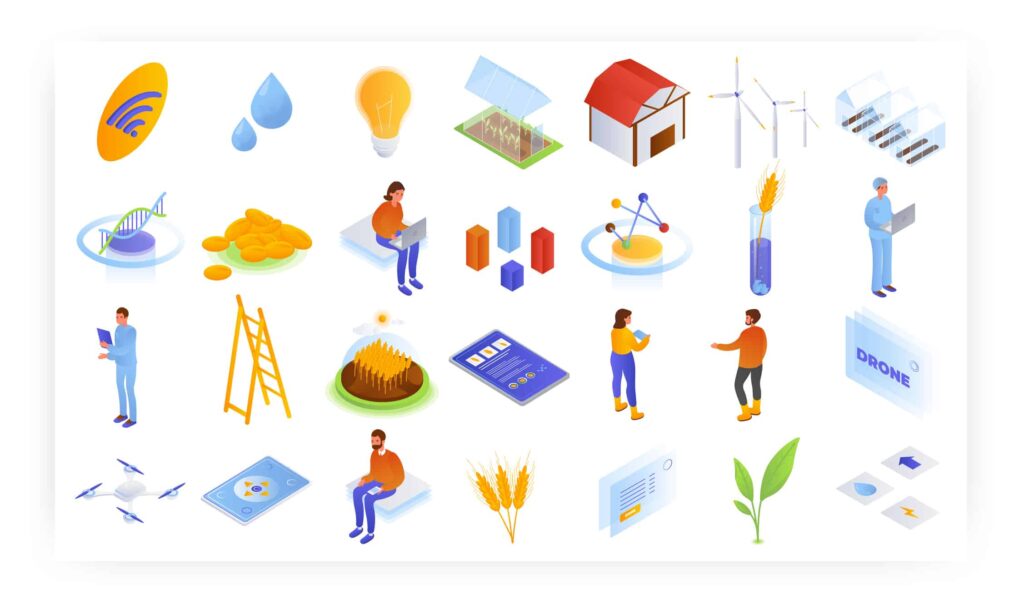
IoT transforms agriculture through precision farming. Farmers can optimize irrigation, monitor soil conditions, and apply fertilizers precisely, resulting in higher crop yields and sustainable practices.
Smart City
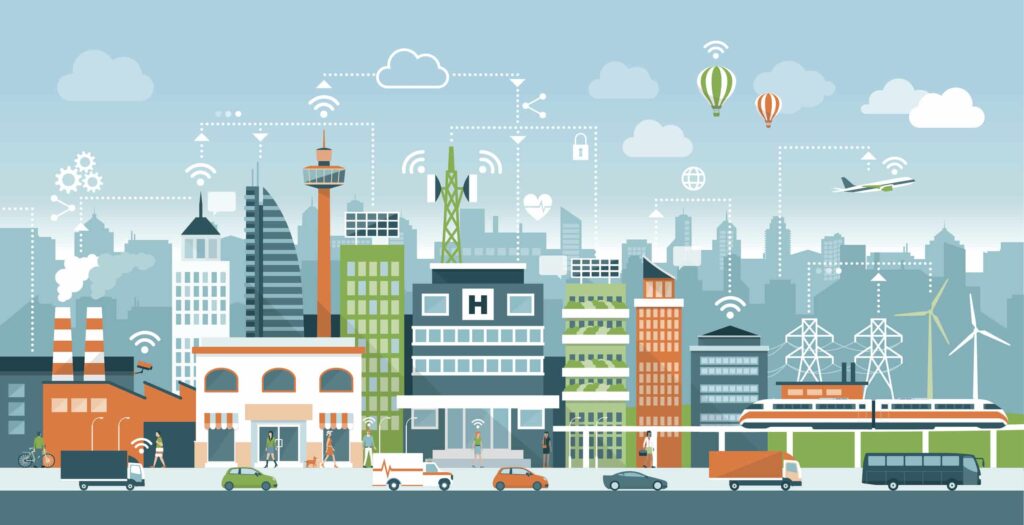
IoT drives the development of smart cities, where connected sensors monitor everything from traffic and air quality to waste management. These data-driven insights improve urban planning and enhance the quality of life for residents.
IoT offerings contain a number of technologies, including edge and cloud computing, which enable smart gadgets to do more than transport and obtain data to their IoT platform. For remote information storage and IoT device management, cloud computing makes the information reachable to all the gadgets in the system. The software programs and algorithms used to method information and make alternatives in real-time are systems gaining knowledge of, and these synthetic intelligence algorithms are utilized in side computing or cloud computing.
Benefits of the Internet of Things
Adopting Internet of Things (IoT) technology brings many advantages that extend across various domains, benefiting businesses, individuals, and society. In this section, we’ll enumerate the critical advantages of embracing IoT, supported by statistics and case studies.
Benefits of IoT for Businesses, Individuals, and Society
Businesses:
- Improved Decision-Making: IoT generates real-time data, enabling data-driven decision-making. In retail, RFID-based inventory management reduces out-of-stock items.
- Workers Safety: In industries like construction, IoT wearables can monitor worker safety, reducing accidents.
- Reduce Cost: IoT-driven efficiency improvements result in substantial cost savings. The adoption of IoT in supply chain management can reduce costs
- Operational Efficiency: IoT streamlines operations by optimizing processes, reducing downtime, and automating routine tasks. For example, in manufacturing, predictive maintenance based on IoT data can increase machinery uptime by up to 20% (Deloitte).
Individuals:
- Convenience: IoT devices simplify daily tasks, from controlling home appliances remotely to receiving health insights through wearable devices.
- Security: Smart home security systems and IoT-enabled healthcare devices provide peace of mind by enhancing personal safety.
- Personalization: IoT-driven services offer personalized experiences, such as tailored recommendations from streaming platforms and smart home automation.
- Energy Savings: IoT-driven smart homes help individuals reduce energy consumption. Automated thermostats, lighting controls, and energy-efficient appliances contribute to lower utility bills. For example, smart thermostats can reduce energy consumption by 10-12% (Nest).
Society:
- Environmental Sustainability: IoT enables smart city initiatives, reducing energy consumption and emissions. Barcelona, for example, reduced energy consumption by 30% through IoT-based urban planning (DataSmart City Solution).
- Healthcare Accessibility: Telemedicine and remote monitoring IoT devices enhance healthcare access for underserved populations, improving overall public health.
- Disaster Preparedness: IoT sensors can detect environmental changes and natural disasters in real-time. This data helps authorities respond swiftly to emergencies, reducing the impact on communities and saving lives.
The benefits of IoT technology across different sectors emphasize its transformative potential for businesses, individuals, and society as a whole.
Challenges of IoT
The Internet of Things presents a unique set of challenges, and effective mitigation strategies are essential to ensure the continued success of IoT. This section will explore these challenges and how they can be addressed.
Data Security
IoT systems generate vast amounts of data, often sensitive and personal, making it challenging to protect this data from unauthorized access and breaches due to the sheer volume and variety of data. In response, many tech companies prioritize data security by adopting industry-standard security protocols and frameworks, implementing robust encryption techniques, and regularly updating devices. These steps significantly lower the risk of unauthorized data access and breaches.
Interoperability
The wide range of IoT devices often follows different standards and protocols, making it complex to ensure the seamless integration of these devices while maintaining interoperability. The industry is adopting open standards and developing protocols that enable cross-device communication to address this challenge. This fosters an environment where IoT devices from various manufacturers can cooperate effectively.
Where does the Internet of Things go next?
The Internet of Things (IoT) is a dynamic field that continues to evolve, presenting exciting possibilities for the future. In this section, we’ll explore the next frontier of IoT, future trends, developments, and areas of innovation that promise to shape the IoT landscape.
Exploring Future Trends and Developments in IoT
5G integration
As 5G networks become more widespread, IoT and industrial devices will benefit from faster data transmission, reduced latency, and enhanced wireless connectivity. This will open doors to real-time applications and remote control on an unprecedented scale.
Edge Computing Expansion
Edge computing will play a more significant role in IoT. Processing data closer to the source will reduce latency and bandwidth requirements. Expect to see increased adoption of edge AI for faster decision-making.
Blockchain
Blockchain technology can enhance the security and transparency of IoT data transactions, particularly in applications like supply chain management and healthcare.
AI and Machine Learning Integration
IoT devices will become smarter by integrating AI and machine learning algorithms. This will enable devices to analyze data locally, make autonomous decisions, and adapt to user preferences.
AI is vital in enhancing automation and intelligence. To learn more about AI’s role in smart homes, explore “The Role of Artificial Intelligence in Smart Homes.”
The Evolution of IoT Technology
Interoperability and Standardization
IoT ecosystems will become more standardized, allowing different devices and platforms to work seamlessly. This will reduce fragmentation and enhance user experiences.
Energy Efficiency
IoT devices will become more energy-efficient, extending battery life and reducing the environmental impact. Energy harvesting technologies, such as solar and kinetic energy, will see increased adoption.
Enhanced Security Measures
With improved encryption, authentication, and intrusion detection systems, IoT security will remain a top priority. Blockchain technology may play a more significant role in securing IoT transactions and data.
Areas of Innovation and Potential Breakthroughs
Healthcare
IoT will revolutionize healthcare with remote patient monitoring, personalized treatment plans, and smart medical devices that continuously collect health data.
Smart Cities
The development of smart cities will accelerate, focusing on sustainability, efficient resource management, and improved urban living through IoT-driven solutions.
Autonomous Vehicles
IoT will be pivotal in advancing autonomous vehicles, enabling real-time communication between vehicles and traffic infrastructure for safer and more efficient transportation.
IoT in Agriculture
Precision agriculture will continue to grow, with IoT sensors and drones optimizing crop management, reducing water usage, and increasing yields.
IoT in Industry 4.0
IoT will drive Industry 4.0, with smart factories using sensor data from connected devices for predictive maintenance, quality control, fleet management, and efficient production.
The future of IoT holds immense potential for innovation and transformation across industries. As technology advances, we can anticipate a world where IoT seamlessly integrates into our daily lives, making them more efficient, sustainable, and connected.
Frequently Asked Questions (FAQ)
What is IoT?
The net of things (IoT) refers to a network of bodily devices, gadgets, home equipment, and physical devices embedded with sensors, software programs, and community connections that acquire and proportion statistics. Those gadgets (also referred to as “smart objects”) vary from simple “smart domestic” gadgets like thermostats to gadgets like smartwatches and RFID-enabled apparel, technology, and transportation. Technologists even see whole “smart cities” based totally on IoT technology.
Explain How IoT works.
Artificial intelligence is the heart of IoT devices. The Internet of Things consists of many things: sensors, cloud components, data processing software, and cutting-edge user interfaces. IoT systems include sensors/devices connected to the cloud via a network. Sensors instantly collect information from the surrounding environment and send it to the cloud infrastructure. Once the data reaches the cloud, the software can process it and decide what to do, such as sending alerts or updating sensors/devices, without user intervention. If the user access is correct, the user interface is required, or they want to control the system. Changes made by the user will be sent via the system from the user interface to the cloud and back to the sensor/device for changes. Therefore, a highly reactive and intuitive device was created, which significantly increases the level of automation.
Why is IoT Device important today?
IoT enhances efficiency, convenience, and safety across industries, improving quality of life and significant technological advancements.
What benefits does IoT offer for businesses and individuals?
Businesses gain improved decision-making and competitive advantages, while individuals enjoy convenience, energy savings, and personalized experiences.
Mostly used sensors in IoT?
Sensors commonly used in IoT systems include:
- Temperature sensors
- Pressure sensor
- Motion detection sensors
- Gas sensor
- Proximity sensor
- IR sensors
- Smoke Sensor
What are the most used IoT protocols?
- Zigbee: Allows for developing secure, scalable, and low-powered IoT solutions.
- CoAP: A lightweight messaging protocol that’s easy to implement and well-suited for resource-constrained devices.
- LoRaWAN: Connects devices to the internet wirelessly. It’s long-range, low cost, and low power consumption.
- Bluetooth: A wireless protocol for short-range communication. It’s low power, low cost, and secure.
- Cellular: Provides high bandwidth and reliable communication. It can send large quantities of data.
- Data distribution service (DDS): A scalable protocol that enables high-quality IoT communication. It allows for interoperable data exchange independently of a hardware and software platform.
- Sigfox: Uses very small frequency bands. It’s used in retail stores, industrial IoT, and smart alarm systems.
- LwM2M: A lightweight protocol suitable for resource-limited terminal equipment management
Explain the characteristics of IoT?
Connectivity: Connectivity is the most essential factor of the Internet of Things. Without linked gadgets or verbal exchange among gadgets, the IoT atmosphere (e.g., sensors, computing engines, information centers, etc.) can’t feature nicely. There are many methods to attach IoT gadgets, such as radio waves, Bluetooth, and Li-Fi.
Analysis/Detection: Once all devices are connected, the next step is analyzing the accrued facts. Use it to improve commercial enterprise acumen. It’s very critical to extract facts from the data generated. For example, sensors produce records; however, unless we interpret these facts correctly, those records will not be helpful.
Collaboration: Most interactions with Internet technology today stem from past associations. Thanks to the Internet of Things, many products, technologies, and services work together in cooperation. Cloud computing in blockchain often leads to the involvement of IoT products.
Scalability: More points are being connected to the IoT field every day. Therefore, IoT deployments must be able to operate at scale. The resulting data is huge and needs to be processed correctly.
Artificial Intelligence: The Internet of Things makes mobile phones, wearables, cars, and other things smart and improves life using data collection, artificial intelligence algorithms, and network technology. For example, if your coffee machine is out of beans, it will order beans from the store you selected.
Where is IoT headed in the future?
IoT is expected to evolve with innovations like 5G connectivity, AI integration, and increased adoption in smart cities and industries.
How can I start implementing IoT in my home or business?
To adopt IoT, identify specific use cases, select compatible devices, and ensure network security measures.
What are the different communication models in IoT?
Request response model
Publisher-Subscriber version
Push-pull model
